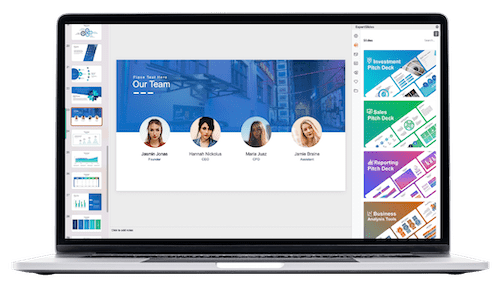Zoom Presentation Mode – Elevate Your Virtual Communication Skills
Zoom Presentation Mode is at the forefront of virtual communication tools in the modern digital era. As remote work and online meetings continue to rise, possessing effective virtual communication skills has become indispensable. Zoom, one of the most widely used platforms for virtual collaboration, provides its robust Presentation Mode to enhance audience engagement and deliver professional presentations.
Key Takeaways
- ✅ Understanding Zoom Presentation Mode is essential for effective virtual communication.
- ✅ Engage your audience by using tips and techniques tailored for Zoom Presentation Mode.
- ✅ Utilize visual aids and interactive tools to enhance your message and keep your audience engaged.
- ✅ Leverage Settings and Advanced Options to optimize your presentation experience.
- ✅ Use
Share Screeneffectively, including Presenter View for PowerPoint and Dual Monitor Mode for enhanced control. - ✅ Enhance your delivery and body language to convey confidence and professionalism in Zoom Presentation Mode.
- ✅ Overcome technical challenges by testing audio, video, and screen-sharing features beforehand.
- ✅ Master virtual backgrounds and lighting to create a professional image while presenting.
- ✅ Utilize keyboard shortcuts like
Alt + Tab(Windows) orCmd + Tab(Mac) for seamless transitions during presentations. - ✅ Engage with participants using polls, Q&A, and breakout rooms to create an interactive experience.
Table of Contents
Zoom Presentation Mode: Key Functionalities
Zoom Presentation Mode provides essential tools for effective virtual presentations. It enables users to maintain eye contact, manage their notes, and control their slides efficiently. This mode is especially useful for educators, business professionals, and public speakers who need to engage their audience effectively.
A key feature is the ability to use Presenter View while sharing slides. This ensures that the presenter can see their notes and upcoming slides while the audience only views the main presentation. For detailed guidance, refer to this complete guide.
Zoom Presentation Mode: Setting Up Presenter View
To enable Presenter View in Zoom Presentation Mode, follow these steps:
- Open your PowerPoint presentation and go to the Slide Show tab.
- Select Use Presenter View to enable speaker notes.
- Start your Zoom meeting and click Share Screen.
- Choose the PowerPoint window displaying the slideshow.
- Ensure that your speaker notes remain visible on your local screen.
For further instructions, visit Zoom's official help page.
Zoom Presentation Mode: Optimizing Video and Audio
High-quality video and audio are critical for an engaging presentation. Consider the following best practices:
Video Quality: Ensure your camera is positioned at eye level and use proper lighting to enhance visibility. A professional or blurred background helps minimize distractions.
Audio Settings: A dedicated microphone improves sound clarity. Additionally, enable Zoom’s noise suppression feature to reduce unwanted background noise.
For more advanced techniques, refer to this guide on interactive presentation tools.
Zoom Presentation Mode: Single vs. Dual Monitor Setup
| Feature | Single Monitor | Dual Monitor |
|---|---|---|
| Presenter View | Requires manual adjustments | Fully supported |
| Audience View Control | Limited | More flexible |
| Multitasking Capability | Restricted | Smoother transitions |
For an in-depth setup comparison, visit this university guide.
Zoom Presentation Mode: Enhancing Engagement
Interactivity is crucial for maintaining audience attention. Here are some features to incorporate:
- Live Polling: Engage attendees with real-time questions and responses.
- Annotation Tools: Highlight key points during the presentation.
- Breakout Rooms: Facilitate group discussions and collaboration.
For more strategies, visit this resource on presentation techniques.
Zoom Presentation Mode: Troubleshooting Issues
Technical challenges can arise while using Zoom Presentation Mode. Below are some common issues and solutions:
Issue: Slides are not displaying properly.
Solution: Ensure the correct window is selected when sharing your screen.
Issue: Audience can see presenter notes.
Solution: Use PowerPoint’s Presenter View and share only the slideshow screen.
For additional troubleshooting tips, explore this guide.
| Visual Aid/Tool | Description |
|---|---|
| 📊 Slide Deck (e.g., PowerPoint) | A traditional slide presentation used to organize and convey key points. |
| 📝 Whiteboard | A virtual whiteboard available in Zoom for sketching ideas or explanations. |
| 🖥️ Screen Sharing | Sharing your screen to display documents, applications, or websites. |
| 🖍️ Annotate Tool | Allows marking up shared content with drawings, highlights, and text. |
| 📊 Polls | Built-in feature for collecting audience responses or feedback. |
| 💬 Chat Box | A text-based communication tool for interaction and Q&A. |
| 🔀 Breakout Rooms | Small, separate meeting spaces for group discussions or activities. |
| 🖼️ Virtual Backgrounds | Custom backgrounds to maintain professionalism or add visual interest. |
| 😊 Emojis and Reactions | Real-time participant feedback using Zoom’s built-in emoji reactions. |
| 🎥 Video Clips | Short, relevant videos shared during the presentation. |
| 📂 Shared Documents | Real-time collaboration on files via links to shared documents or Zoom’s in-meeting tools. |
| 🌟 Spotlight Video | Focuses the view on one speaker or presenter during the session. |
| ✋ Hand-Raising Feature | Allows participants to signal when they wish to speak or ask a question. |
| 📈 Graphs and Charts | Visual representations of data shared via slides or shared screen. |
| 🔤 Closed Captioning | Text captions displayed in real-time for accessibility. |

Zoom Presentation Mode: Best Practices for Seamless Screen Sharing
Screen sharing is one of the most crucial aspects of Zoom Presentation Mode. To ensure a seamless experience, always close unnecessary tabs and applications before starting your presentation. This not only minimizes distractions but also improves performance. Using the ‘Share Specific Window’ option in Zoom Presentation Mode ensures that participants see only what’s relevant, preventing accidental exposure of personal files or notifications.
Another important tip is to optimize for full-screen mode. If you’re presenting slides, using Zoom’s ‘Slide Control’ feature allows you to maintain fluid navigation. Furthermore, adjusting the screen-sharing resolution settings can help reduce lag, particularly if you’re dealing with animations or videos in your presentation.
Zoom Presentation Mode: Comparing Different Presentation Views
| Presentation View | Best For | Key Advantage |
|---|---|---|
| Speaker View | Personalized presentations with a focus on the speaker | Keeps engagement high by showing facial expressions |
| Gallery View | Interactive discussions with multiple participants | Ideal for collaborative sessions and panel discussions |
| Side-by-Side Mode | Presenting slides while keeping the speaker visible | Balances visual content with speaker presence |
| Immersive View | Creative and engaging visual layouts | Makes virtual meetings feel more natural and connected |
Zoom Presentation Mode: Leveraging Virtual Backgrounds Effectively
Virtual backgrounds in Zoom Presentation Mode can enhance professionalism and eliminate distractions. When choosing a background, opt for a clean, neutral design that doesn’t clash with your presentation. If you’re in a corporate setting, branding your background with a company logo can reinforce your identity.
Lighting plays a critical role in making virtual backgrounds look natural. Using a green screen or ensuring even lighting helps avoid visual distortions. Zoom Presentation Mode also offers the ‘Blur Background’ option, which is useful for maintaining focus on the speaker while subtly concealing any distractions in the background.
Zoom Presentation Mode: Enhancing Accessibility for All Viewers
Accessibility is an important consideration when using Zoom Presentation Mode. Live captions and automatic transcription can help attendees who are deaf or hard of hearing follow along more easily. Additionally, enabling the ‘Pin Speaker’ function ensures that individuals with visual impairments can keep the focus on the main speaker throughout the presentation.
Providing downloadable slides and transcripts after the session ensures that attendees can review the material at their own pace. Zoom Presentation Mode’s screen reader compatibility also makes it easier for individuals with disabilities to navigate the platform and engage with the content effectively.
Zoom Presentation Mode: Final Thoughts on Maximizing Impact
Mastering Zoom Presentation Mode takes practice, but the benefits it brings to online communication are well worth the effort. By optimizing screen sharing, leveraging advanced features, and maintaining engagement, you can create a polished and professional presentation experience. Whether you’re leading a corporate meeting, hosting a webinar, or delivering an educational lecture, using Zoom Presentation Mode strategically can enhance clarity, interaction, and impact.
As virtual meetings continue to be a key component of modern communication, staying proficient in Zoom Presentation Mode ensures that you can confidently share your ideas with any audience, anywhere in the world.

Foto von Christina Morillo von Pexels
FAQ - Zoom Presentation Mode
How do I enable Zoom Presentation Mode?
To enable Zoom Presentation Mode, follow these steps:
- Open Zoom and start a meeting.
- Click on Share Screen and select your presentation window.
- Enable Slide Control if using PowerPoint or Google Slides.
- Use the
Alt + Tabshortcut (Windows) orCommand + Tab(Mac) to switch windows seamlessly.
How can I make my Zoom presentations more engaging?
Here are some effective strategies:
- Use high-quality visuals and animations.
- Engage your audience with Zoom’s polling and reaction features.
- Incorporate interactive elements like Q&A sessions.
- Maintain eye contact with the camera to build rapport.
Can I use Zoom Presentation Mode with multiple screens?
Yes! If you have multiple monitors, you can:
- Designate one screen for your presentation.
- Use the other screen for speaker notes and participant view.
- Choose Advanced Sharing Options to select the correct screen.
Why is my audio not working when I start Zoom Presentation Mode?
Check the following settings:
- Ensure your microphone is selected under Audio Settings.
- If using external speakers or a headset, check the default output device.
- Restart Zoom and try again.
How can I avoid lag when sharing my presentation?
To minimize lag:
- Close unnecessary applications running in the background.
- Use a wired internet connection instead of Wi-Fi.
- Reduce the resolution of your shared screen if needed.
How do I add live captions during a Zoom presentation?
You can enable live captions by:
- Going to Settings > Accessibility > Enable Closed Captioning.
- Using third-party apps like Otter.ai for automatic transcriptions.
- Manually assigning a participant as a captioner.
What is the best way to engage my audience in Zoom Presentation Mode?
Try these engagement techniques:
- Use the Annotate tool to highlight key points.
- Enable Live Polls to gather real-time feedback.
- Encourage Q&A using the Zoom Chat feature.
How can I use Presenter View in PowerPoint while sharing in Zoom?
Follow these steps:
- Open your PowerPoint presentation.
- Click Slideshow > Use Presenter View.
- In Zoom, share only the Slideshow Window instead of the full screen.
How do I record my Zoom presentation for future use?
To record your presentation:
- Click Record on the Zoom toolbar.
- Choose between Local Recording or Cloud Recording.
- After the meeting, Zoom will automatically process and save the recording.
How can I ensure smooth transitions between slides?
Use these tips:
- Use keyboard shortcuts like
Arrow Keysfor slide navigation. - Practice transitions in advance.
- Avoid excessive animations that might cause lag.
Can I use a virtual background while in Zoom Presentation Mode?
Yes, you can! Follow these steps:
- Go to Settings > Background & Effects.
- Choose an appropriate virtual background or upload your own.
- Ensure proper lighting for a smooth effect.
How can I exit Zoom Presentation Mode quickly?
Press Esc or stop screen sharing from the Zoom toolbar.
Related Posts
Recent Posts
Main Menu
Knowledge base
Useful Links







